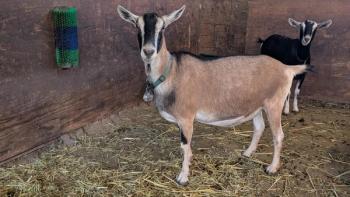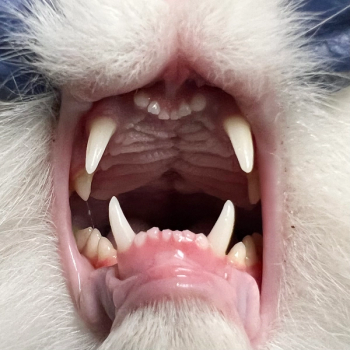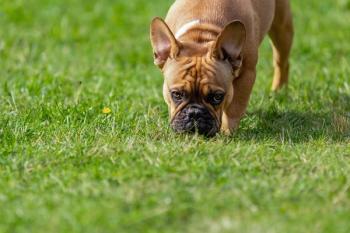
Diaphragmatic, inguinal, & perinial hernia repair (Proceedings)
Hernia refers to the abnormal protrusion of an organ or tissue through a normal or abnormal opening in the abdominal muscles or in the diaphragm. The term is commonly used to denote bulging of organs through the muscular part of the abdominal wall.
Hernia
Hernia refers to the abnormal protrusion of an organ or tissue through a normal or abnormal opening in the abdominal muscles or in the diaphragm. The term is commonly used to denote bulging of organs through the muscular part of the abdominal wall.
Hernias are classified according to type and location. According to type they are:
• Reducible - the hernia contents can be returned to the abdominal cavity by manipulation.
• Irreducible - the hernia contents cannot be returned to the abdominal cavity without surgical intervention; adhesions of the herniated tissues to adjacent structures.
• Strangulated - the hernial contents are constricted at or by the hernial ring, resulting in vein congestion and eventual development of endotoxin shock and gangrene of the herniated tissue.
Inguinal hernias
These hernias are characterized by protrusion of intestine or other viscera through the inguinal canal. They are fairly common in the dog and occur more frequently in bitches. Ingninal hernias are not common in the cat. In the bitch inguinal hernias are found most often in the pregnant or old intact animal and the hernial sac may contain a gravid or diseased uterus. Inguinal hernias are rare in the male dog. when present it may extend to become an inguinoscrotal hernia, Inguinal hernias in puppies may disappear spontaneously, Predisposition to inguinal hernia has been suggested and it may have a hereditary basis. A structural weakness can be present in the inguinal area of the bitch, The frequencies of inguinal hernia in a pregnant birch may be attributed to increased abdominal pressure. Obesity can be a predisposing factor The resistance of the mammalian inguinal region to herniation of viscera may depend on the neuromuscular reflex mechanism of the lower abdominal wall rather than on the resistance of the inguinal rings. Whether the lesion is congenital or acquired, there seems to be a structural defect in the region. The internal and external rings are almost superimposed and there is no intervening canal; thus a gap is present in the abdominal floor.
Clinical signs
Inguinal hernia is manifested by a protrusion of abdominal contents near the inguinal canal, Although most inguinal hernias are unilateral, careful examination may reveal the condition to be bilateral, The hernial contents are soft, doughy, and painless on palpation; this varies, however, depending on the contents and length of time that the hernia has been present. The swelling may be so small as to be obscured by the candal mammary glands or fat pads. The swelling might be large enough to contain a gravid uterus or one with pyometra. When the hernia extends beyond the external ring in a caudal direction (labial hernia) it may be lateral to the vulva and may resemble a perineal hernia.
Diagnosis
If the hernia is easily reduced, determining the location of the hernial ring is possible. Reduction of the hernia may be assisted by elevating the hindquarters while the animal is in dorsal recumbency. When pressure in the caudal portion of the abdominal cavity is thus reduced, the hernial ring may be palpable.
If it is difficult or impossible to reduce the hernia because of incarceration or strangulation of intestine or growth of a fetus after herniation of the uterus, the diagnosis becomes more difficult, The swelling may be confnsed with a mammary tumor, cyst, hematoma or abscess.
An abscess is usually warm and accompanied by fever and leukocytosis. There are usually signs of pain when an abscess is palpated and the swelling is not so freely movable as that of a hernia, Cysts and hematomas are not warm and usually take considerable time to develop. These are most easily diagnosed by palpation,' they are firm and may be lobulated or nodular. Lipomas in the inguinal region may be difficult to differentiate from a hernia, however It must be kept in mind that a mammary gland or tumor may conceal a small hernia.
Exploratory puncture and aspiration of the swelling contents have been advocated as a diagnostic measure, but this should be done with caution.
Radiographic diagnosis
Radiography is helpful to differentiate intestine, gravid uterus, or bladder in the hernial sac, Barium contrast material is helpful if the digestive tract is involved. When the herniated uterus is gravid and in late gestation, the fetal skeleton will be visible on scout films, If gestation has been less than 43 days, a lobulated fluid density will be apparent.
When the bladder is involved, signs of cystitis are associated with the hernia. After administration of 10% Sodium Iodide or air, a cysrogram will reveal the presence of the bladder in the sac. A decrease in the size of the hernia may be observed following urination or urinary bladder catheterization. Although some inguinal hernias may be readily diagnosed, in others the bulge in the inguinal region may be so insignificant as to defy detection, Only a small portion of the intestine may be incarcerated in the inner ring. These animals are presented with signs of intestinal obstruction. The cause of such a radiographically demonstrable obstruction may be ascertained only by exploratory laparotomy.
Surgical correction
Ventral midline approach is used for all inguinal hernias allowing utilization of both inguinal rings and repair of bilateral hernias through a single incision. In addition, this incision maybe extended cranially without disruption of the mammary tissue or its' blood supply.
The incision is made from the cranial brirn of the pelvis and brought cranial until adequate exposune of the sac is accomplished. Undermining of the mammary tissue and lateral retraction allows for exposure of the ingninal ring and sac. Blunt dissection frees the sac from the subcutaneous tissue. The hernial sac is opened and inspected Adhesions between tbe sac and viscera are removed and sac contents are returned to the abdominal cavity.
Often enlargement of the inguinal ring is accomplished in order to ease hernial reduction. Should bladder be included, aspiration simplifies the procedure.
After organ replacement, the sac is trimmed at the margins of the inguinal ring and the hernial ring sutured with simple interrupted (2-0) stainless steel.
Inspection is made of the opposite inguinal ring, vaginal process removed and inguinal ring sutured closed. Mammary tissue is replaced and a penrose drain inserted. Routine dosure of skin follows.
Post-operative care includes an abdominal wrap bandage which eliminates dead space and helps the comfort of the patient. Drains are removed 3 - 5 days post-operatively.
Perineal hernia
These hernias differ from other hernias in that the displaced organs are not usually within a peritoneal sac. A specific cause has not yet been established for perineal hernias and multiple causative agents are most likely. It has been attributed to failure or weakening of the fascia and muscles of the perineum, permitting abdominal or pelvic organs to prolapse into the space created by atrophy or injury of the pelvic diaphragm.Although perineal hernias have been reported in the bitch, it occnrs most commonly in intact male dogs over 8 years old, It does, however, occur in young animals, A structural predisposition has been suggested and dogs with rudimentary tails such as Boston Terriers would be more susceptible. Also reported is a hormonal imbalance etiology. This theory is supported by evidence that some dogs with perineal hernia are concurrently afflicted with testicular tumors, prostatic enlargement or enlargement of a cystic uterus musculinea.
Constipation has been cited as a factor in perineal hernia but this has not been firmly established as a cause but more often a result of prostatic enlargement.
Clinical signs
Most patients are presented for examination because they have been observed straining to defecate. Also, a swelling lateral to and extending from some distance ventral to the anus is a common sign. The hernial swelling is soft and fluctuate and manipulation often results in reduction of contents. If the bladder and prostate are hernial contents then the swelling may be turgid. if the bladder has become incarcerated or strangulated due to distension with urine following herniation, reduction might only be possible by withdrawing urine from the bladder. A perineal hernia may be bilateral, in which case the whole perineal region is swollen and the anus is displaced caudally.
Diagnosis
A hernia is apparent when the contents of the swelling can be pushed back into the pelvic cavity. This may be facilitated by elevating the animal's hindlimbs. Simultaneous palpation of the perineal enlargement and rectal examination aids in determining whether there is continuity between the swelling and peritoneal cavity, Digital examination of the rectum often reveals a lateral deviation or diverticulum into the hernial area. This deviation results in accumulation of feces in the rectum, and causes the animal to strain. During the course of the examination, the feces can be removed from the diverticulum, It then will be possible to pass the finger into it and observe its movement under the skin.
Affected patients may only display the usual signs of discomfort, but if the bladder becomes strangulated and distended with urine following herniation, the swelling may be greatly enlarged and the overlying skin may be tense, blue-red, and exude serum. It may or may not be possible to catheterize the bladder in this case. The diagnosis of bilateral hernia sometimes is difficult because its reduction is not easy. A large unilateral hernia may migrate ventral to the anus into the opposite side and appear to be bilateral.
Treatment
Most cases of perineal hernia are not emergency cases. However, those with acute complications, such as retroflexion of the bladder and inability to urinate, must be treated as emergencies.
Relief can often be obtained by passing a catheter into the bladder. if this is not possible, urine can be removed by performing paracentesis. A 20 gauge needle or smaller is adequate. Once the bladder is emptied, an attempt can be made to reduce the hernia. When the hernial contents have been reduced, the animal should be given a narcotic to mimmize straining. Such patients are suitable candidates for surgery in 24 hours. Once the diagnosis has been established surgery should not be delayed. if surgery is delayed the patient should be fed a low-residue diet for 48 hours prior to surgery. The feces are then soft in consistency and the danger of post-operative wound disruption is reduced, Recurrence of perineal hernia is not common and has been reported to recur in two to forty percent of the cases.
Repair of perineal hernia
The hernial funnel extends from the pelvic cavity to the hernial sac lateral to the anus. The hernia is limited ventrally and laterally by the walls of the pelvis and medially by the rectum.
The levator ani is a thin fan-shaped muscle that arises from the pelvic surface of the ischium and pubis at the pelvis symphysis, the cranial border of the pubis and the pelvic surface of the shaft of the ilium. It is inserted on the external anal sphincter and caudal vertebrae. The two muscles together with their fascial layers form the pelvic diaphragm through which the genitourinary and digestive tracts open to the ontside, When these muscles separate, relax, or become atrophic, the abdominal or pelvic organs may push through the defect. The hernia occurs between the external anal sphincter and the levator ani muscles. if the perineal fascia which surrounds the anus and is confluent with the gluteal fascia stretches or ruptures, the hernial contents prolapse lateral to the anus and are confined only by the skin.
Surgical technique for perineal hernia repair
A purse-string suture is placed around the anus to prevent defecation during the operation. It is best to place the patient on its sternum and elevate the hindquarters. The tail is pulled forward and laterally to expose the perineal region. The operation is designed to reconstruct the pelvic diaphragm. Complete reconstruction may not be possible due to tearing or atrophy of muscle; closure of the hernial funnel and obliteration of space may be all that can be accomplished.
A half circle skin incision is made over the hernia and extended an adequate distance above and below the hernia to facilitate manipulation of the tissues. Frequently there will be no evidence of fascia and fibrous tissue, and the muscles will be atrophied and interminged with omentum-like, necrotic, fatty tissue, The tissue strands must be disrupted between muscle layers and the fatty tissue ligated and removed as necessary. The area is likely to be hemorrhagic and blood serum escapes when the hernial sac is entered.
The herniated organs are replaced into the pelvic cavity by gentle manipulation and then a clear view of the funnel is obtained. On the medial side is the rectum, terminating at the anal sphincter. This usually is the only structure on the medial side into which sutures can be inserted. The muscular structures on the lateral side of the funnel are not easily seen but may be identified by palpation. The levator ani and coccygeous muscle are on the dorsolateral surface of the funnel, 2-0 Stainless steel wire suture is inserted through these muscles and into the dorsal part of the anal sphincter. The internal obturator muscle is also sutured to the ventrolateral aspect of the rectnm.
Immediately below these sutures, additional ones are inserted between the anal sphincter and sacrotuberous ligament. This ligament is a fairly broad band that can be identified by passing the finger along the medial wall of the pelvis and hooking the finger backward. The ligament may be mistaken for bone. The lower portion of the opening is closed by inserting a series of sutures through the internal obturator muscle which lies on the floor of the pelvis, and the ventral surface of the anal sphincter. This is difficult because the structures lie deeply within the pelvis and careful manipulation is necessary.
When inserting the lower sutures between the head of the internal obturator muscle and ventral portion of the anal sphincter, care must be taken to avoid injuring the blood and nerve supply to the anus, The muscles of the anal sphincter are supplied by anal branches of the pudendal nerve and by the perineal arteries and satellite veins, These structures will be encountered in a band along the ventral aspect of the rectum. Injury to the nerve might result in fecal incontinence.
The sutures should not be tied until all have been inserted,' otherwise increasing difficulty will be encountered in placing the sutures. Following closure of the initial suture line an attempt is made to locate intact perineal fascia that may have retracted laterally. The edge of the fascia is grasped with an Allis forceps and a flap is formed by dissecting the outer surface of the fascia away from the overlying skin, The fascia flap is pulled medially and sutured to the most caudal portion of the anal sphincter. Another series of sutures is inserted in the subcutaneous tissues and excessive skin is trimmed to assure adequate and accurate closure.
Possible complications following repair of a perineal hernia include fecal and urinary incontienance, wound infection from fecal contamination and lameness resulting from damage to the sciatic nerve during surgery. In severe cases, nylon mesh may be used to form a "diaphragm" that prevents the caudal displacement of the viscera.
Post-operative care and prognosis
Routine prophylactic chemotherapy is advisable and a low residue diet should be fed to prevent excessive straining during defecation, In most cases recurrence is not a problem. Both sides of a bilateral hernia should not be operated at the same time since this would put too much stress on the external anal sphincter. A 4 to 6 week lag should occur between surgeries, unless a newer obturator lift method is employed.
Obturator lift for simultaneous bilateral perineal hernia repair
The approach to this surgery is identical to traditional repair, and after exposure herniated organs are retropulsed back into the abdomen. Identification of the external anal sphincter, sacrotuberous ligament and the internal obturator is severed at the point that it passes laterally over the body of the ischium, The muscle is then brought dorsally to fill the defect left by the hernia, Initial suture is placed between the lateral aspect of the external anal sphincter and the sacrotuberous ligament and gluteal fascia as far dorsal as possible in oder to create a bed for the apex of the internal obturator is sutured to the caudomedial edge of the sacrotuberous ligament with 4 - 6 size 0 PDS sutures in a cruciate pattern. The caudomedial border of the internal obturator is likewise sutured to the external anal sphincter. Preplacement of all sutures before knot's are thrown facilitates the task. Layered subcutaneous closure is accomplished with gut to obliterate dead space Skin cbsure is routine.
Traumatic diaphragmatic hernia
This condition is usually the result of blunt trauma especially from automobile accidents. Diaphragmatic hernia should be considered in all patients with a history of trauma. It is believed that the diaphragmatic tear is the result of a sudden increase in intra-abdominal pressure. The pressure differential is only momentary and the pressures equilibrate readily.
Clinical signs - diaphragmatic hernia
This hernial condition may be difficult to identify because of marked or absence of conventional presenting signs. Thus the patient may be presented with imperceptible to life threatening clinical signs. The severity of the patient's condition is dependent upon several factors, the most important of which is a reduction in tidal volume. Loss of tidal volume is the result of a decrease in intra-thoracic space due to the presence of abdominal viscera1 fluid or both. Other conditions that may be present are rib fractures, pneumothorax, lung contusion, and shock. A potentially more dangerous situation exists when the stomach is in the thorax and gas cannot escape causing it to become increasingly larger.
The clinical Signs most frequently seen in acute diaphragmatic hernia is dyspnea. Often the dog rests in a sitting position with the elbows abducted, Physical examination reveals intestinal sounds in the thorax, muffled heart sounds and reduced lung field. The area of dullness in percussion is increased. Careful abdominal palpation may reveal the absence of abnormal position of individual organs such as stomach, liver, spleen. In a study of 116 dogs at Ohio State University, College of Veterinary Medicine, the most common organs displaced into the thorax in diaphragmatic hernia cases were in decreasing order - liver, small intestine, stomach, spleen, fluid and omentum. Other displaced organs were also reported such as pancreas, colon, gallbladder, cecum, kidney, falciform ligament and uterus.
A dog suspected of having a diaphragmatic hernia should not be elevated by the hindquarters to see if the dyspnea becomes worse. This technique can cause sudden pressure on the lungs and heart when a large tear is present and can cause overwhelming interference with ventilation and venous return.
Radiographic diagnosis
Lateral and dorsoventral radiographs often will confirm the diagnosis. The normal diaphragmatic line is usually absent in the radiographs. Gastric or intestine gas patterns and/or radiopaque organs such as liver or spleen may be visible in the thorax displacing normal thoracic viscera. It should be noted that the organs noted in the chest at the time of radiographs were not necessarily the same as those found. at surgery. This is attributable to the free movement of viscera between pleural and peritoneal cavities in many patients. Diaphragmatic hernia maybe difficult to diagnose at the time of initial injury because of lack of clinical signs. Gradually developing clinical signs, such as intermittent vomiting, anorexia, dyspnea or reduced exercise tolerance may be seen weeks, months or even years following the trauma.
Newsletter
From exam room tips to practice management insights, get trusted veterinary news delivered straight to your inbox—subscribe to dvm360.






